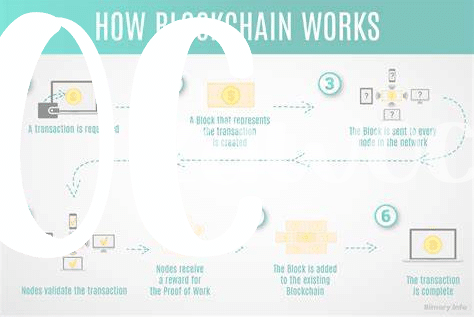🌐 Introduction to Blockchain: a World of Possibilities

Imagine stepping into a digital universe where every transaction, agreement, and transfer is recorded on an unbreakable chain of blocks – welcome to the world of blockchain. It’s like a virtual ledger that’s not just for tech enthusiasts or financial wizards but for anyone intrigued by the promise of a secure, transparent, and decentralized way of managing data. At its core, blockchain is a breakthrough that’s all about trust. Whether it’s buying your morning coffee, selling an old guitar, or even voting in an election, blockchain’s magic lies in its ability to let everyone involved check and trust the transaction history without needing a middle-man. This technology is not confined to cryptocurrencies like Bitcoin or Ethereum; its potential stretches far and wide across various sectors, from healthcare, where it can secure patient records, to the art world, where it ensures the authenticity of artworks. This world of possibilities is only just unfolding, inviting us to explore the myriad of ways blockchain can transform our daily lives.
| Area of Impact | Potential Uses of Blockchain |
|---|---|
| Finance | Secure transactions, Cryptocurrencies |
| Healthcare | Patient records management, Drug traceability |
| Art & Entertainment | Proving authenticity, Royalties tracking |
| Supply Chain | Traceability of goods, Reducing counterfeits |
🔍 the Magic of Transparency: Why It Matters
In the world of blockchain, transparency isn’t just a nice-to-have, it’s the very foundation that the technology is built on. Imagine a system where every transaction is out in the open, visible for anyone to see. This level of openness isn’t just about keeping things fair; it’s about building trust. In traditional systems, we often have to rely on what people tell us. But with blockchain, we can see everything for ourselves. It’s like having a ledger that’s not just open for the public to view, but also impossible to tamper with. This means that every move is authentic, creating a sense of security and reliability that’s hard to find elsewhere.
However, this transparency comes with its challenges. While it’s great to have everything out in the open, it also means that there’s very little room for privacy. Every transaction you make, every move you take is out there for the world to see. This can be a bit unnerving. After all, privacy is also a fundamental right. It’s the delicate balance between being open and maintaining a private space that makes the blockchain space so intriguing. For those interested in how these aspects play out in more complex scenarios, such as the impact of Bitcoin halving events on value, this detailed examination https://wikicrypto.news/the-future-roadmap-bitcoins-halving-vs-ethereum-20 sheds light on the intricate balance of factors in the crypto world.
🎭 the Art of Staying Private: a Necessity

In the digital age, our lives are like open books. This makes protecting our personal information not just a choice, but a must. Imagine if everything you did online was visible to anyone. A bit scary, right? That’s where privacy comes in. It’s like having a safe where you keep all your secrets, and only you know the combination. It’s crucial in keeping our digital selves secure and giving us control over what we share and with whom. Privacy helps us maintain our autonomy in the online world, ensuring that our personal details, like where we spend our money or who we talk to, stay just that—personal.
But achieving total privacy isn’t just about locking everything away. It’s like a dance, where sometimes you step into the light and sometimes you step back into the shadows. In blockchain, where every transaction can be seen by anyone, finding ways to keep some things private is a true art. Technologies and strategies, like encryption or private transactions, offer us ways to share what we want and hide what we don’t. This balance keeps our digital lives both open and our own, letting us enjoy the perks of the digital world without giving up our right to privacy. As the digital landscape evolves, so too will the ways we protect our privacy within it, always ensuring our right to choose what we share remains in our hands.
⚖️ Striking the Balance: a Delicate Dance

Finding that sweet spot where everyone playing in the digital sandbox feels their secrets are safe but can still peek over the fence feels more like tightrope walking without a net. Think of it as hosting a masquerade ball online: guests want to swirl in mystery yet not bump into the furniture. In this intricate dance, trust is the floor, and technology, the music. Technologies that champion privacy, like those secret handshakes between devices, need to blend seamlessly with glass-house transparency. This balancing act isn’t just nice to have – it’s essential for keeping the gears of innovation moving and the lights on in the world of crypto. To understand more about how this delicate balance impacts the ecosystem, including what impacts bitcoin value and the blockchain, diving deep into the mechanics can reveal much about the whispers and shadows that shape our digital future.
Yet, this dance floor is ever-expanding, welcoming new dancers each day who bring their own steps and missteps. Some come tiptoeing in privacy cloaks, while others glide under the disco ball of transparency, dazzling onlookers. Learning from those who’ve tripped or shone is vital, like breadcrumbs leading through the forest. Each tale of success or faceplant adds a layer to our understanding, painting a richer picture of how to balance the scales between open books and locked diaries. In their stories lies the blueprint for engineering a world where privacy and transparency don’t just coexist; they flourish. This ensemble, unpredictable and diverse, choreographs the future of blockchain, where every step, dip, and turn matters.
🗝️ Real-world Examples: Learning from Successes and Failures
When we peek into the world of blockchain, the stories of Bitcoin and Ethereum often come to the forefront; they serve as shining examples of transparency in action, showcasing every transaction publicly to ensure trust and integrity. However, this very transparency raises eyebrows when privacy comes into play. Zcash and Monero dance to a different tune, prioritizing privacy by obscuring the sender, receiver, and amount of transactions. Their success highlights the importance and demand for privacy in digital transactions. Yet, the road to balancing transparency and privacy is not without its bumps. Facebook’s Diem (formerly Libra) faced pushback from regulators worldwide, fearing it could compromise user privacy and financial stability, illustrating the delicate dance of balancing these two aspects. These real-world examples serve as a classroom for the blockchain community, teaching valuable lessons on respecting user privacy while maintaining the necessary level of transparency.
| Project | Focus | Lesson Learned |
|---|---|---|
| Bitcoin & Ethereum | Transparency | Public trust through visible transactions |
| Zcash & Monero | Privacy | The value of anonymity in digital transactions |
| Diem (Facebook) | Balance Attempt | Navigating regulatory waters is key |
🚀 Future Trends: Where Transparency and Privacy Meet

Looking into the crystal ball of blockchain, we see an exciting future where the line between transparency and privacy is not just a thin one but an innovative blend. The tech world is abuzz with ideas 💡, and one of the most anticipated trends is the evolution of blockchain platforms that offer the best of both worlds. Imagine a digital space where transactions are open enough to build trust among users yet private enough to protect their data like a treasure chest. It’s a bit like having a room with glass walls that can turn opaque with the flip of a switch. This delicate balance could bring about a revolution in how digital identities and assets are managed, making the internet a safer place for everyone.
This bright future isn’t just a daydream; it’s a possibility grounded in the real progress happening today. For those curious about how current blockchain giants like Bitcoin and Ethereum are paving the way, a deeper dive into their mechanics can be enlightening. By understanding the differences in their approaches to transparency and privacy, we can glimpse what future platforms might look like. If you’re wondering how to buy bitcoin versus ethereum, you’re starting at the right place. The journey from here is toward an era where transparency and privacy don’t just coexist but complement each other, opening up a world of possibilities for users and developers alike. The balancing act 🎭 between these two aspects is set to define the future of blockchain, promising an exciting ride ahead. 🚀
